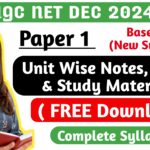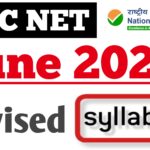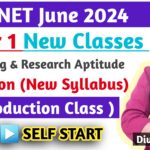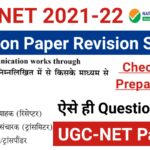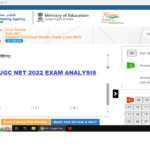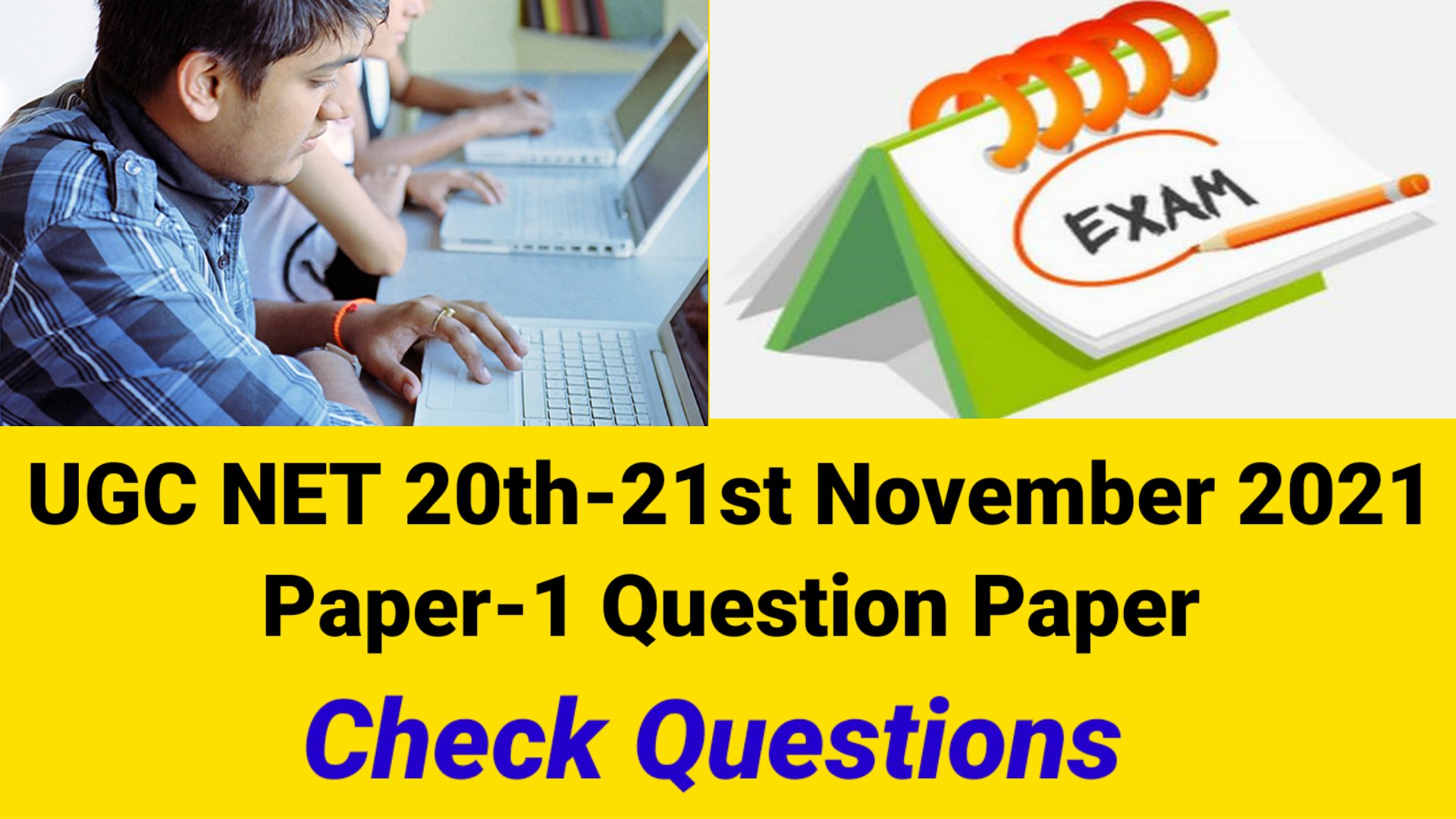Check UGC NET 20th & 21st November 2021 Paper 1 Question Paper Analysis & Answer Key Complete Details
Detailed UGC NET 20st November 2021 Paper 1 Question Paper Analysis Shift1 & 2
Detailed UGC NET 21st November 2021 Paper 1 Question Paper Analysis Shift 1


UGC NET 20th November 2021 Paper 1 Question Paper Analysis -Day 1 of UGC NET 2021 is being on November 20 in two shifts – 9:00 AM to 12:00 PM and 3:00m PM to 6:00 PM. Day 1 is being conducted for almost 36 subjects, and Paper 1 is common for all subjects. Paper 1 of UGC NET consists of questions related to teaching & research aptitude, reasoning, mathematics and much more. Paper 1 consists of 50 questions, and each question carries 2 marks which means the total weightage of the first paper is 100. On the other hand, Paper 2 is conducted for 200 marks. On this page, you can check the detailed question paper analysis of UGC NET 20th November 2021 Paper 1 along with a memory-based question paper and answer key.
The official answer key of UGC NET 2021 is expected to be released by the December Last .
Important Highlights of UGC NET 20th November 2021 Shift 1 Analysis
Some of the major highlights of UGC NET 20th November 2021 Shift 1 Analysis are as follows –
Teaching Aptitude-Key Behavior of teaching ,Level of teaching
Research Aptitude -Ethics / Method of Teaching
Communication-Classroom Communication , Barrier of Communication Statement wise
Data interpretation-Moderate level Time consuming
ICT-Bluetooth & WIFI Difference ,
Indian Logic- Hetu Related Question middle & Major Term ,Hetvabhas & Pramana
Environment-Climate Change ,Global Warming ,Cop 26 , Ozone Depletion & Natural Hazards
Higher Education-NAAC, SWAYAM, SWAYAMPRABHA year
Question Asked in Ugc net 2021 Shift 1 20 November
Q-The First Open university was established in the year ?
Ans- 1982
Q2-Swayam
Q3-Heuristic method of teaching was developed by ?
Ans-Armstrong
Q4 acf egi ikn oqt ?
Ans UWZ
Q5 – Asthadyayi Writer ?
Ans-Panini
Q6- A researcher attempt to evaluate the effect of method of feeding on anxiety proneness of children which method of research would be appropriate ?
Expost Facto
Q7 Empirical Research is social Science is associated with –
Ans-Positivist Philosophy
Q8 -In pre learning preparation an important stage of communication is –
Ans- Information Acquisition and its Processing
Important Highlights of UGC NET 20th November 2021 Shift 1 Analysis
Paper 1 was not too tough in Shift 1, and there were no unexpected surprises. The paper was on expected lines. From communication, there were questions on barriers to communication. There were also questions on research ethics. Some of the major highlights of UGC NET 20th November 2021 Shift 1 Analysis are as follows –
Difficulty Level of Paper 1: Moderately Easy
Difficulty Level of Comprehension Questions: Easy
Difficulty Level of Research Aptitude Questions: Moderate
Difficulty Level of Teaching Aptitude Questions: Moderate
Difficulty Level of Reasoning Questions: Moderate
Difficulty Level of Mathematics Questions: Easy to Moderate (question on ratio, profit & loss, average)
Difficulty Level of Data Interpretation-Moderate
Topics Asked in Shift 1: Questions in Shift 1 were asked on the following topics –
- NAAC
- SWAYAM
- Ozone Depletion
- Global Warming
- Hazards (statement-based question)
- Difference between Bluetooth and WiFI
- Hetu
- Pramaan
- Indian Logic
- Classroom Communication (statement-based questions)
- Barriers to Communication
- Ethics (research)
- Methods of Teaching
- Key Behaviours of Teaching
- Helpful Behaviours of Effective Teaching
- Ratio Proportion (male-female bifurcation)
- Memory Hierarchy
- Qualitative Research
- File Transfer Protocol (FTP)
- VLE
- AGB (Advance Graphic Port)
- Input & Output Devices (2 Questions)
- COP-25 Question from Environment
- Paris Agreement
- Bio-Diversity Decade
- Sakshat Portal
- Reserach Design
Shift 1 vs 2 Difficulty Level Comparison: To be Updated
Detailed UGC NET 20th November 2021 Paper 1 Question Paper Analysis
The detailed analysis of UGC NET 20th November 2021 Paper (Shift 1 & 2) can be checked in the table below –
| Name of the Topic | Difficulty Level | Total No. of Questions Asked |
| Teaching Aptitude | Available Soon | 11-13 |
| Research Aptitude | Available Soon | 07-09 |
| Reading Comprehension | Available Soon | 05 |
| Reasoning | Available Soon | 04-05 |
| Data Interpretation | Available Soon | 05 |
| Mathematics | Available Soon | 03-04 |
| Communication | Available Soon | 03-05 |
| People & Environment | Available Soon | 03-04 |
| Higher Education System | Available Soon | 03-04 |
| Information & Communication Technology | Available Soon | 02-03 |
For a memory-based question paper, you can click on the link below –
Updated Soon !
| UGC NET Cutoff | UGC NET Results 2021 | UGC NET Paper Analysis 2021 (All Shifts) | UGC NET Subject wise Exam Date PDF |
UGC NET 2021 Day 1 (Nov 20) Latest Updates
November 20, 2021, 9:32 AM: So far, NTA has only released the admit cards for exams scheduled till November 24
November 20, 2021, 9:02 AM: Shift 1 of UGC NET 2021 Day 1 has started across the country
November 20, 2021, 8:42 AM: The Shift 1 exam timings are 9:00 AM to 12:00 PM. The morning shift exam is taking place for 19 subjects
November 20, 2021, 8:11 AM: The reporting process for Shift 1 at the exam centers is underway, and the gate will be closed at 8:30 AM
Important Highlights of UGC NET 20th November 2021 Shift 2 Analysis
Some of the major highlights of UGC NET 20th November 2021 Shift 2 Analysis are as follows –
Difficulty Level of Paper 1: Moderate Level
Difficulty Level of Teaching & Research Aptitude Questions: Moderate Level
Difficulty Level of Reasoning Questions: Moderate to Difficult
Difficulty Level of Mathematics Questions: Moderate to Difficult
Was the Paper Time Consuming? To be Updated
Topic with Most Number of Difficult Questions: To be Updated
Shift 1 vs 2 Difficulty Level Comparison: Almost Similar Difficulty Level
Detailed UGC NET 20th November 2021 Paper 1 Question Paper Analysis
The detailed analysis of UGC NET 20th November 2021 Paper (Shift 1 & 2) can be checked in the table below –
| Name of the Topic | Difficulty Level | Total No. of Questions Asked |
| Teaching Aptitude | Moderate | Available Soon |
| Research Aptitude | Moderate | Available Soon |
| Reading Comprehension | Easy | Available Soon |
| Reasoning | Moderate to Difficult | Available Soon |
| Data Interpretation | Moderate to Difficult | Available Soon |
| Mathematics | Difficult | Available Soon |
| Communication | Easy to Moderate | Available Soon |
| People & Environment | Easy | Available Soon |
| Higher Education System | Easy | Available Soon |
| Information & Communication Technology | Moderate | Available Soon |
Topics Asked in Shift 2: Questions in Shift 2 were asked on the following topics –
- VOIP
- HTML
- Decimal Binary Convert
- SDG & MDG
- Highest Solar Producer
- Brutland Commission Year
- Null Hypothesis
- Critical Thinking
- Fallacy
- Hetvabhasa
- Environment day Matching
- Vyapti Types
- CBCS Related
- Formative Evaluation
- CRT/NRT
- Blood Relation
- Ration /Proportion
- Full Form NITI Ayog
- IOT Full form
- Paralanguage
- WAV file format
- MOOC
- Square of oppsition
Question Asked in Ugc net 2021 Shift 1 20 November
Q1-Dislexia related to
Answer-With reading disorder
Q2 A Variable that is Manipulated ?
Answer-Independent Variable
Q3 Context free Generalization Research ?
Answer-
Q4 Body Language falls under which communication ?
Q5 matching -Upword /Downword/Vertical/Horizontal Communication
Q6 A good communicator begins his/her presentation with –
Answer-Easy Rehersal
Q7 Effectiveness of teaching has to be judged in terms of –
Answer-Learning outcomes of students
Q8-According to Blooms Taxonomy the highest level of learning in cognitive domain is –
Answer-Evaluation
Q9 Statement Question-Swayam /MOOC Full form
Q10 VOIP full form
Answer-Voice over internet protocol
Q11 HTML fulll form-
Answer-Hyper text mark up language
Q12- Full form of NITI Ayog ?
Answer-National Institution for Transforming India, better known as NITI Aayog, was formed via a resolution of the Union Cabinet on 1 January 2015. NITI Aayog is the premier policy think tank of the Government of India, providing directional and policy inputs.
नेशनल इंस्टीट्यूशन फॉर ट्रांसफॉर्मिंग इंडिया, जिसे नीति आयोग के नाम से जाना जाता है, का गठन 1 जनवरी 2015 को केंद्रीय मंत्रिमंडल के एक प्रस्ताव के माध्यम से किया गया था। नीति आयोग भारत सरकार का प्रमुख नीति थिंक टैंक है, जो दिशात्मक और नीति इनपुट प्रदान करता है।
Q13 Semantic Barrier
Q14 SDG/MDG Year
Q15 Brutland Commision established ?
Answer -1983
Q16 IGNOU established in ?
Answer-1985
Q17 CRT/NRT
Q18 Hetvabhas Matching
Q19 Formative Evaluation
Q20 Critical thinking teaching level-
Berlow Taxonomy
Detailed UGC NET 21st November 2021 Paper 1 Question Paper Analysis
The detailed analysis of UGC NET 21st November 2021 Paper (Shift 1 ) can be checked in the table below –

| Name of the Topic | Difficulty Level | Total No. of Questions Asked |
| Teaching Aptitude | Moderate | 4-5 |
| Research Aptitude | Moderate | 4-5 |
| Reading Comprehension | Easy | 5 |
| Reasoning | Moderate to Difficult | 3-4 |
| Data Interpretation | Moderate to Difficult | 5 |
| Mathematics | Difficult | 5 |
| Communication | Easy to Moderate | 3-4 |
| People & Environment | Easy | 3-4 |
| Higher Education System | Easy | 5-6 |
| Information & Communication Technology | Moderate | 3-4 |
Topics Asked in Shift 1: Questions in Shift 1 were asked on the following topics –
- NPTEL
- Teaching Domain
- Percentage
- SDG
- Teaching level
- Education Commission Matching
- Upman Comparison
- hetvabhasa
- Computer Memory Bit/Byte
- Nation Education Policy
- Environment agreement
- NITI full form
- HDD full form
- Group Communication
- Alternative Research /HO
- Percentage/Average
- Effective Teaching
- Communication Barrier
- Cyclone Average
- Berlow Taxonomy
- Field Dependent
- Clock question
- Slippery slop
- Renewable energy
- Least noise
- Research Ethics
- Narrative
- Wind Speed
- Number series
- Field Dependent
- Mixture Milk
Question Asked in 21st Nov 2021 First Shift
Q NPTEL fill Form ?
NPTEL is an acronym for National Programme on Technology Enhanced Learning which is an initiative by seven Indian Institutes of Technology (IIT Bombay, Delhi, Guwahati, Kanpur, Kharagpur, Madras and Roorkee) and Indian Institute of Science (IISc) for creating course contents in engineering and science.
NPTEL नेशनल प्रोग्राम ऑन टेक्नोलॉजी एन्हांस्ड लर्निंग का एक संक्षिप्त रूप है जो सात भारतीय प्रौद्योगिकी संस्थानों (IIT बॉम्बे, दिल्ली, गुवाहाटी, कानपुर, खड़गपुर, मद्रास और रुड़की) और भारतीय विज्ञान संस्थान (IISc) द्वारा पाठ्यक्रम सामग्री बनाने के लिए एक पहल है। इंजीनियरिंग और विज्ञान।
Q2 HDD full form ?
A hard disk drive (HDD) is a traditional storage device that uses mechanical platters and a moving read/write head to access data. A solid state drive (SSD) is a newer, faster type of device that stores data on instantly-accessible memory chips.
एक हार्ड डिस्क ड्राइव (HDD) एक पारंपरिक भंडारण युक्ति है कि का उपयोग करता है यांत्रिक थाली और एक चलती पढ़ने / डेटा एक्सेस करने हेतु लिखने प्रमुख होता है। सॉलिड स्टेट ड्राइव (SSD) एक नया, तेज़ प्रकार का उपकरण है जो डेटा को तुरंत-सुलभ मेमोरी चिप्स पर संग्रहीत करता है।
Q3 NITI full form ?
National Institution for Transforming India
नेशनल इंस्टीट्यूशन फॉर ट्रांसफॉर्मिंग इंडिया , जिसे नीति आयोग के नाम से जाना जाता है, का गठन 1 जनवरी 2015 को केंद्रीय मंत्रिमंडल के एक प्रस्ताव के माध्यम से किया गया था। नीति आयोग भारत सरकार का प्रमुख नीति थिंक टैंक है, जो दिशात्मक और नीति इनपुट प्रदान करता है।
Q4 What is required for good teaching ?
Q5 Attributes ,action, and apperances in the context of classroom communication are considered as ?
Through Body posture, gestures, attitudes, action, eye contacts, facial expressions i.e. any form of expression. Hence, Attitudes, actions, and appearances in the context of classroom communication are considered as non-verbal.
शारीरिक मुद्रा, हावभाव, दृष्टिकोण, क्रिया, नेत्र संपर्क, चेहरे के भाव यानी अभिव्यक्ति के किसी भी रूप के माध्यम से। इसलिए, कक्षा संचार के संदर्भ में अभिवृत्तियों, क्रियाओं और दिखावे को अशाब्दिक माना जाता है ।
Q6 Which of the following Lerner Characterstics is highlyWhich of the following learner characteristics is highly related to effectiveness of teaching ?
(1) Prior experience of the learner
(2) Educational status of the parents of the learner
(3) Peer groups of the learner
(4) Family size from which the learner comes. related to the effectiveness of teaching ?
निम्नलिखित में से कौन सी शिक्षार्थी विशेषताएँ शिक्षण की प्रभावशीलता से अत्यधिक संबंधित हैं?
(1) शिक्षार्थी का पूर्व अनुभव
(2) शिक्षार्थी के माता-पिता की शैक्षिक स्थिति
(3) शिक्षार्थी के सहकर्मी समूह
(4) परिवार का आकार जिससे शिक्षार्थी आता है।
Q7 Level of teaching Matching

Q8 Teaching Domain-Reflective Teaching
Q9 Water Pollution
Q10 Upman Comparison
Upamāṇa (Sanskrit: “comparison”), upamana in Hinduism, is a pramāṇa, or means of having knowledge of something. … It also means getting the knowledge of an unknown thing by comparing it with a known thing. For example, assume a situation where a man has not seen a gavaya or a wild cow and doesn’t know what it is.
उपमाना (संस्कृत: “तुलना”), हिंदू धर्म में उपमान, एक प्रमाण है, या किसी चीज का ज्ञान रखने का साधन है। … इसका अर्थ किसी ज्ञात वस्तु से तुलना करके किसी अज्ञात वस्तु का ज्ञान प्राप्त करना भी है । उदाहरण के लिए, एक ऐसी स्थिति की कल्पना करें जहां एक आदमी ने गवया या जंगली गाय नहीं देखी है और यह नहीं जानता कि यह क्या है।
Q11 Commision /Kothari /Mudalier/Radhakrishana Chronological order
| Commission | Appointed on | Purpose |
| Radhakrishnan Commission (University Education Commission) | November 1948 | The first Commission on education after Independence.The major emphasis was on higher education.Appointed under the chairmanship of Dr Sarvepalli Radhakrishan .The aim was to report on Indian University Education and to suggest improvements to suit the present and future requirements of the country. |
| The Mudaliar Commission (The Secondary Education Commission) | September 23, 1952 | The aim was to reform Secondary Education.Dr A. Lakshamanswami Mudaliar was appointed as the ChairmanThe objectives of secondary education included the development of democratic citizenship, improvement of vocational capability and efficiency, education for leadership and development of personality. |
| Kothari Commission | July 14, 1964 | Daulat Singh Kothari was made the ChairmanThe aim was to survey all aspects of the educational system at all levels and give suggestions to help the education system to progress at all levels.Social objective – to enable the underprivileged classes to use education as a tool for improving their social and economic situation. |
Hence, the various commissions, the Radhakrishnan Commission, the Mudaliar Commission and the Kothari Commission were constituted chronologically in 1948, 1952 and 1964, respectively.
स्वतंत्रता के बाद की अवधि में, भारत सरकार और राज्यों की एक प्रमुख चिंता राष्ट्रीय प्रगति और सुरक्षा के लिए एक महत्वपूर्ण कारक के रूप में शिक्षा पर ध्यान देना रहा है। भारत सरकार द्वारा शिक्षा की बेहतरी के लिए उच्च शिक्षा प्रणाली पर विभिन्न आयोगों की स्थापना सहित उपाय किए गए।
| आयोग | पर नियुक्त | प्रयोजन |
| राधाकृष्णन आयोग (विश्वविद्यालय शिक्षा आयोग) | नवंबर 1948 | शिक्षा पर पहला आयोग स्वतंत्रता प्राप्ति के बाद।उच्च शिक्षा पर विशेष बल दिया गया ।Appointed under the chairmanship of Dr Sarvepalli Radhakrishan.इसका उद्देश्य भारतीय विश्वविद्यालय शिक्षा पर रिपोर्ट देना और देश की वर्तमान और भविष्य की आवश्यकताओं के अनुरूप सुधार का सुझाव देना था। |
| मुदलियार आयोग (माध्यमिक शिक्षा आयोग) | 23 सितंबर 1952 | इसका उद्देश्य माध्यमिक शिक्षा में सुधार करना था ।डॉ ए लक्ष्मणस्वामी मुदलियार को अध्यक्ष के रूप में नियुक्त किया गया थामाध्यमिक शिक्षा के उद्देश्यों में लोकतांत्रिक नागरिकता का विकास, व्यावसायिक क्षमता और दक्षता में सुधार, नेतृत्व के लिए शिक्षा और व्यक्तित्व का विकास शामिल था। |
| कोठारी आयोग | 14 जुलाई 1964 | दौलत सिंह कोठारी को अध्यक्ष बनाया गयाइसका उद्देश्य सभी स्तरों पर शिक्षा प्रणाली के सभी पहलुओं का सर्वेक्षण करना और शिक्षा प्रणाली को सभी स्तरों पर प्रगति में मदद करने के लिए सुझाव देना था।सामाजिक उद्देश्य – वंचित वर्गों को अपनी सामाजिक और आर्थिक स्थिति में सुधार के लिए शिक्षा को एक उपकरण के रूप में उपयोग करने में सक्षम बनाना। |
इसलिए, विभिन्न आयोग, राधाकृष्णन आयोग, मुदलियार आयोग और कोठारी आयोग क्रमशः 1948, 1952 और 1964 में कालानुक्रमिक रूप से गठित किए गए थे।
Q12 Nation education policy NEP-5+3+3+4
Answer-All higher education institutes excluding the medical and law colleges will be governed by a single regulator.
MPhil courses will now be terminated.
Board exams will now be more application and knowledge-based.
Both the public and private higher education institutes will be governed under the same norms.
To promote and give more emphasis on the regional language/mother-tongue, instruction medium up to class 5 will be in local/home languages.
All entrance exams for higher education institutes and universities will be held commonly.
School curriculum to focus more on core concepts.
Vocational education will also be imparted from 6th grade onwards.
10+2 study culture discontinue and new structure of 5+3+3+4 will be followed, subjecting to the respective age group of 3-8, 8-11, 11-14 and 14-18 years.
मेडिकल और लॉ कॉलेजों को छोड़कर सभी उच्च शिक्षा संस्थान एक ही नियामक द्वारा शासित होंगे।
एमफिल कोर्स अब बंद कर दिए जाएंगे।
बोर्ड परीक्षा अब अधिक आवेदन और ज्ञान आधारित होगी।
सार्वजनिक और निजी दोनों उच्च शिक्षा संस्थान समान मानदंडों के तहत शासित होंगे।
क्षेत्रीय भाषा/मातृभाषा को बढ़ावा देने और उस पर अधिक जोर देने के लिए कक्षा 5 तक का शिक्षण माध्यम स्थानीय/घरेलू भाषाओं में होगा।
उच्च शिक्षा संस्थानों और विश्वविद्यालयों के लिए सभी प्रवेश परीक्षाएं सामान्य रूप से आयोजित की जाएंगी।
मुख्य अवधारणाओं पर अधिक ध्यान केंद्रित करने के लिए स्कूल पाठ्यक्रम।
छठी कक्षा से व्यावसायिक शिक्षा भी दी जाएगी।
10+2 अध्ययन संस्कृति बंद हो जाती है और 5+3+3+4 की नई संरचना का पालन किया जाएगा, जो संबंधित आयु वर्ग 3-8, 8-11, 11-14 और 14-18 वर्ष के अधीन होगा।
Q13 Group Communication
Group communication is the act of sending and receiving messages to multiple members of a group. In a business environment, groups often use this type of communication to exchange ideas, determine goals and motivate other members.
समूह संचार एक समूह के कई सदस्यों को संदेश भेजने और प्राप्त करने का कार्य है । एक कारोबारी माहौल में, समूह अक्सर विचारों का आदान-प्रदान करने, लक्ष्य निर्धारित करने और अन्य सदस्यों को प्रेरित करने के लिए इस प्रकार के संचार का उपयोग करते हैं

Q14 wind speed
Q15 Which of the given learner characteristic are associated with field dependent ?
From the following list of learner characteristics, identify those which are associated with ‘field-independent learners.’
A. Focuses on facts and principles
B. Perceives global aspects of concepts and materials
C. Prefers and likes to compete
D. Can organize information by himself/herself
E. Likes to cooperate
Choose the correct answer from the options given below:
A, B and C only
B, C and D only
A, C and D only
C, D and E only
शिक्षार्थी विशेषताओं की निम्नलिखित सूची से, उन लोगों की पहचान करें जो ‘क्षेत्र-स्वतंत्र शिक्षार्थियों’ से जुड़े हैं।
A. तथ्यों और सिद्धांतों पर ध्यान केंद्रित करता है
बी अवधारणाओं और सामग्रियों के वैश्विक पहलुओं को समझता है
C. प्रतिस्पर्धा करना पसंद करता है और पसंद करता है
D. सूचनाओं को स्वयं/स्वयं व्यवस्थित कर सकते हैं
ई. सहयोग करना पसंद करता है
चुनें सही विकल्प नीचे दिए गए से जवाब:
A, B and C only
B, C and D only
A, C and D only
C, D and E only
Q16 Formative /Summative Assertion reason
Q17 Renewable Energy
Answer-The major types of renewable energy sources are:
Biomass. Wood and wood waste. Municipal solid waste. Landfill gas and biogas. Ethanol. Biodiesel.
Hydropower.
Geothermal.
Wind.
Solar.
There are four major types of nonrenewable resources: oil, natural gas, coal, and nuclear energy. Oil, natural gas, and coal are collectively called fossil fuels. Fossil fuels were formed within the Earth from dead plants and animals over millions of years—hence the name “fossil” fuels.
Q18 24578:33667 :: 46586 : ?
Q19 Cyclone average speed ?
A cyclonic disturbance in which the maximum average surface wind speed is in the range of 48 to 63 knots (89 to 118 km/h). A cyclonic disturbance in which the maximum average surface wind speed is 64 knots (119 km/h) or more. Speed of movement of the centre of the tropical cyclone.
एक चक्रवाती विक्षोभ जिसमें अधिकतम औसत सतही हवा की गति 48 से 63 समुद्री मील (89 से 118 किमी / घंटा) की सीमा में होती है । एक चक्रवाती विक्षोभ जिसमें अधिकतम औसत सतही हवा की गति 64 समुद्री मील (119 किमी/घंटा) या अधिक है। उष्णकटिबंधीय चक्रवात के केंद्र की गति की गति।
Q 20 Berlow taxonomy
Q21 SDG Asserttion Reason
Q 22 Invironment related agreement

Q23 Computer memory


Q 24 Slippery Slop
A slippery slope argument (SSA), in logic, critical thinking, political rhetoric, and caselaw, is an argument in which a party asserts that a relatively small first step leads to a chain of related events culminating in some significant (usually negative) effect.
एक फिसलन ढलान तर्क (एसएसए), तर्क, आलोचनात्मक सोच, राजनीतिक बयानबाजी और केसलॉ में, एक तर्क है जिसमें एक पार्टी का दावा है कि एक अपेक्षाकृत छोटा पहला कदम संबंधित घटनाओं की एक श्रृंखला की ओर जाता है जो कुछ महत्वपूर्ण (आमतौर पर नकारात्मक) प्रभाव में समाप्त होता है। .
Q25 Education Day ?
National Education Day is observed on November 11 every year, since 2008, to commemorate the birth anniversary of independent India’s first education minister Maulana Abul Kalam Azad. He played a significant role in shaping the education system of the country.
Q26 Bharat ka bhavishya ka nirman uski class me ho rha hai kisne kha ?
Oxford University in England in the professor has read Muzammil said citing Kothari Commission that it is written on the first page that India ‘s destiny to build his classes happening is. He said that in addition to the Principal and Vice Chancellor, teachers have an important role in the management of educational institutions .
भारत के भविष्य का निर्माण हमारी कक्षा में हो रहा है यह कथन कोठारी आयोग जो कि 1962 में बना था शिक्षा से संबंधित आयोग है किसने कहा था कि भारत का निर्माण भारत का भविष्य का निर्माण उनकी कक्षाओं में हो रहा है ऐसा वक्त कोठारी आयोग ने कहा था


